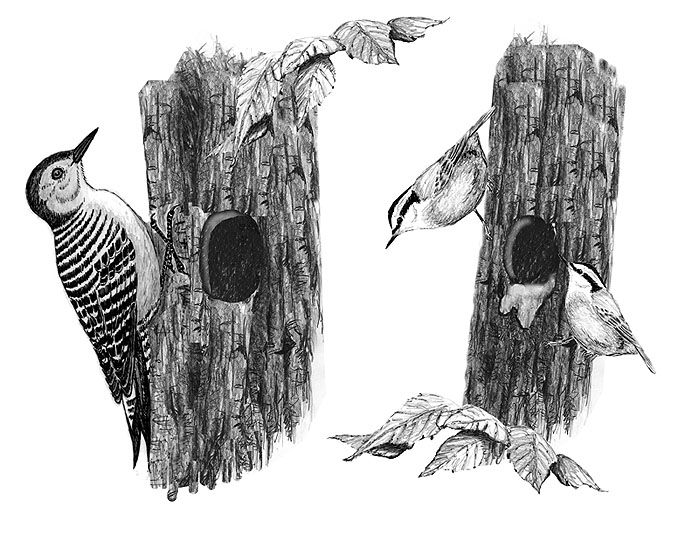
Spring birding trip…sort of:
In the past, my spring birding trips have ranged from Alaska to Newfoundland to other birdie places in between. This year, however, the lovely pandemic has forced me to remain in the ‘hood for a while. As a result, I’ve had to find bird activity closer to home, which sounds dull, but I have found something interesting. At least, I think it’s interesting, but you know me.
Not far from my house there’s an area around a small kettle pond owned by the local conservation trust. The main access to this area is down a long, steep flight of 28 very scary stairs. These stairs make visiting the location a challenge, which is bad, but they have also prevented this important habitat from becoming another one of the trust’s notorious dog parks. That’s good.
On an early May walk I noticed a pair of Red-breasted Nuthatches busily working on a dead tree. Like bluebirds and Tree Swallows, nuthatches build their nests in tree cavities. But unlike those two other birds, nuthatches have the skills needed to construct their own cavity, provided the tree is dead and decaying. Watching the pair work was both entertaining and a lesson in the couple’s dynamics. While the female chipped away at the wood, the male was beside her every step of the way. He anxiously quivered his wings as she worked and would routinely put his head into the hole to examine the progress, although he never really did much of the excavating himself. In fact, he was more of a hindrance than a help. It’s like when I assist my wife in the kitchen. I might peel a potato or two, but for the most part, I’m just in her way.
About fifty feet down the same trail, I came upon another couple that was also hard at work on a nesting cavity. But they weren’t tiny nuthatches chipping into soft wood; they were a pair of robust Red-bellied Woodpeckers putting the finishing touches on a much larger hole in a living red oak. Unlike the nuthatch couple, the workload here was evenly distributed. The male wasn’t just a supervisor, but actually helped with the excavating. The whole process was fascinating and I wanted to watch longer, but I had to get to work and I knew it would take me a while to climb back up those stairs.
I didn’t visit the area again for several days. (I couldn’t face those awful stairs again right away.) Upon returning, I made two interesting discoveries (at least I think they’re interesting, but…). The entrance hole to the nuthatch nest now looked sort of gooey. What the heck? I flipped up my binoculars and discovered that the front of the hole had been “painted” with sticky, dripping tree sap. I’ve read that Red-breasted Nuthatches spread sap around the front of their nesting cavities in an effort (it is thought) to keep away predators, but this was the first time I had seen it myself. The birds apply the sap with their beaks and sometimes will even use “tools,” in the form of tree bark, to spread the sap. See, I told you it was interesting. Who doesn’t like a good sap story?
Over at the woodpecker homestead, things were quiet. There was no sap or other signs of activity. I eventually saw the female in a nearby tree and she had also seen me, and wasn’t happy about it. (I get that a lot.) Not wanting to come closer to me, she began to call for her mate. Where was he, you ask? He was inside the hole, keeping the eggs warm. When he heard her, he immediately popped his head out and called back. With nuthatches, it is the female that does all of the incubating, but red-belly couples share this chore. She was out and about while he was at home, sitting on the eggs. That’s pretty contemporary and noble of him…but can he peel potatoes?
About a week later, I revisited this location (and descended those dreadful stairs one more time). My timing could not have been better. As I stood on the ground, staring up at the nuthatch tree, a tiny egg suddenly appeared in the hole. Actually, it was only the shell of an egg and the mother was carrying it away. The babies had just hatched! Yay! Over the next few minutes the female made several trips in and out of the nest, carrying bits of shell each time she left, while also being careful to avoid the sap trap. Where was the male during all of this? Good question. I think that’s what she wanted to know, too. Don’t worry; he eventually showed up, but had some explaining to do.
Meanwhile, at the woodpecker nest, things were even more exciting. The red-belly eggs had apparently hatched a few days earlier and now both parents were racing back and forth with caterpillar-ish things for the chicks. Once again, the female kept her distance when I arrived, but the male was totally fine that I was there. He kept flying in with food and didn’t mind me one bit. He knew another cool dude when he saw one.
It was fun to watch two cavity nesting species, living fairly close to each other, having decidedly different breeding methods. One species was clever enough to use tools and sap to protect its nest, while the other was better at distributing domestic chores. And it was taking place right near my house. Maybe next year things will be better and I’ll be able to take a real spring birding trip. Hopefully, by then, I can visit a location that is a little more exotic, has more unusual birds and, most importantly, a lot fewer stairs.